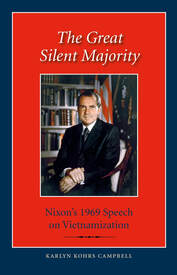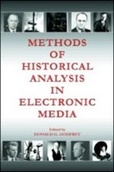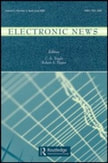Academic Publications
|
Peer reviewed journal articles
Agnew, ABC, and Nixon's War on Television
Dale L. Cressman (Routledge & AEJMC, 2020). Agnew, ABC, and Richard Nixon's War on Television News. Journalism History Vol 47, (No. 1, March 2021), 27-53. Less than a year into the presidency of Richard Nixon, Vice President Spiro Agnew launched a series of attacks on television journalists, accusing them of being biased and having too much power to determine what news millions of Americans watched on their televisions. Because their stations were licensed and regulated by the government, the networks understood Agnew's statements to be threats. As the smallest, most vulnerable network, ABC hade the most reason to be concerned. However, it also food itself at a confluence of relationships with the administration: It employed both Nixon's favorite and least favorite anchormen, as well as a highly-placed executive who lent sympathy and assistance to the White House; one of its senior correspondents went to work for the president; and it aired a popular television show with the assistance of the FBI. This article focuses on ABC during Nixon's war on television. It draws from 18 manuscript collections in 11 libraries, five interviews, and declassified FBI documents obtained through a freedom of information request. Article online link: https://doi.org/10.1080/00947679.2020.1845042 Journalism History: https://journalism-history.org Download accepted manuscript from BYU Scholar Archive (free) Podcast interview about article More about the Elmer Lower project Related book review published in Presidential Studies Quarterly, DOI: 10.1111/psq.12214 |
|
The First New York Times Western Edition
Dale L. Cressman (Routledge & AEJMC 2021). Project Westward Ho: The First New York Times West Coast Edition. Journalism History. Vol 47 (No. 2, June 2021), 135-158. In 1954, the New York Times began receiving letters from residents of California, requesting that the newspaper begin publishing a Western edition. After the Times began using tele-typesetting to publish same-day editions of its European edition, it was persuaded to publish an edition in California. Beginning in October 1962, the Times was printed in Los Angeles and distributed throughout the Western United States. However, financial losses suffered as a result of the New York newspaper strike, the difficulty in attracting advertisers, and the death of the project's sponsor, led to the edition's demise in January 1964. Using archival sources, this article describes the development of the short-lived West Coast edition, a signature project for Times publisher Orvil Dryfoos. Use of tele-typesetting and the publication's effect on the Los Angeles Times are considered. Article online link: https://doi.org/10.1080/00947679.2020.1866406 Journalism History: https://journalism-history.org More about 1963 project |
|
Electric signs and the New York Times "zipper"
Dale L. Cressman (2018). News in Lights: The Times Square Zipper and Newspaper Signs in an Age of Technological Enthusiasm. Journalism History 43(4), 198-208. Winner of the 2018 Michael S. Sweeney Award During the latter half of the nineteenth century, when the telegraph had produced an appetite for breaking news, New York City newspaper publishers used signs on their buildings to repair headlines and promote their newspapers. Originally, chalkboards were used to post headlines. But, fires competition led to the use of new technologies, such as magic lantern projections. These and, later, electrically lighted signs, would evoke amazement. In 1928, during an age of invention, the New York Times installed an electric "moving letter" sign on its building in Times Square. Popularly known as "the zipper," the monograph drew significant attention from New Yorkers over the next thirty years and contributed to the reorganization of readerships into audiences; it both anticipated television and was eclipsed by it. Drawing on the records of the New York Times Company, this article traces the history of newspaper signs and the zipper, while correcting the historical record regarding the inventor of the sign. Article online link: https://doi.org/10.1080/00947679.2018.12059181 Download article More about Times Sq project |
|
Robert Capa and Elmer Lower
Steven Holiday and Dale L. Cressman (2016). "What Deepest Remains": How Photojournalistic Mutualism between Robert Capa and Elmer Lower Shaped Modern Concepts of World War II. American Journalism 33(4), 442-464. As American combat photographers documented the horrors and heroism of every major front of World War II, photo editors worked behind the scenes to bring their images to publication. Matching photographers with assignments and selecting images that best told the story—all while navigating censorship, publication expectations, and intercultural societal norms—the photo editor was indispensable to the combat photographer. The partnership of Robert Cap and Elmer W. Lower exemplified such a mutualistic relationship. Whether serendipitous, as it was early in the war when Lower provided assistance in exchange for Capa's photos, or calculated, as it was later in the war when both were employed by Life magazine, their experience exemplifies the mutually beneficial relationship of war photographers and their editors. Article online link: http://doi.org/10.1080/08821127.2016.1241644 Download published article (publisher access required) Download accepted manuscript from BYU Archive Scholar (free) More about the Elmer Lower project |
|
The History and Meaning of Times Square
Dale L. Cressman (Ohio University, 2009). From Newspaper Row to Times Square: The Dispersal and Contested Identity of an Imagined Journalistic Community. Journalism History 34(4), 182-193. Until the early twentieth century, Park Row was synonymous with New York newspapers. Of the newspapers that left Park Row, The New York Times was notable for having established a geographic landmark that was identified with the newspaper. In fact, by 1906, Times Square had replaced Park Row as a place for New Yorkers to get the election news or to celebrate New Year’s Eve. Nevertheless, Times Square did not remain associated with its newspaper namesake. Drawing on the Archives of the New York Times Company, this article traces the history of Times Square from the construction of Times Tower, through the twentieth century, as the Times loses its identity as the neighborhood’s namesake. Article online link: https://doi.org/10.1080/00947679.2009.12062772 Download article More about Times Sq project |
|
The NFL's First Season on Network Television
Dale L. Cressman and Lisa Swenson (Routledge & BEA, 2007). The Pigskin and the Picture Tube: The National Football League’s First Season on Network Television. Journal of Broadcasting and Electronic Media 51(3): pp. 479-497. This article describes the efforts of the Columbia Broadcasting System to telecast the National Football League’s 1956 season on the CBS Television Network. The network established a pattern of multiple regional telecasts and a shift from local to network control of professional football telecasts. Drawing on historical documents and oral history interviews, the article describes the conditions that led CBS to consider telecasting professional football. In addition, it examines the negotiations between the network and the NFL as well as the technical and contractual challenges that CBS had to overcome for professional football’s first full season on network television. Article online link: https://doi.org/10.1080/08838150701457537 Download article More about the Elmer Lower project |
|
ABC’s Feud with NASA
Dale L. Cressman (AJHA, 2007). Fighting for Access: ABC’s 1965-66 Feud with NASA. American Journalism 24(3): pp. 133-151. This article examines the American Broadcasting Company’s dissatisfaction with the National Aeronautics and Space Administration (NASA) during 1965 and 1966, as voiced in a series of critical speeches by the president of the network’s news division, Elmer W. Lower. Such public criticism was highly unusual at a time when NASA and the television networks shared a symbiotic relationship and American space exploration was widely celebrated. ABC’s unhappiness stemmed in part from what its news division president deemed as limited access to information as well as the absence of television cameras in the Gemini space vehicles. NASA cited technical reasons for keeping television cameras out of the Gemini capsules. However, this article also cites astronaut resistance as a contributing factor to the absence of onboard television cameras. A difficult personal relationship between ABC’s space correspondent and the space agency’s director of public affairs may have further motivated ABC’s criticism of NASA. Article online link: https://doi.org/10.1080/08821127.2007.10678082 Download article More about the Elmer Lower project |
|
Swearing in Teen-oriented Movies
Dale L. Cressman, Mark Callister, Tom Robinson, and Chris Near (Routledge, 2009). Swearing in the cinema: An analysis of profanity in US teen-oriented movies, 1980-2006. Journal of Children & Media. The exposure of children to profanity continues to be a concern for parents, media researchers, and policy makers alike. This study examines the types, frequency, and usage of profanity in movies directed at and featuring teenagers. A review of relevant literature explores the nature, use, and psychology of profanity, its potential social effects, and its prevalence in the media. A content analysis was conducted of the 90 top-grossing domestic teen films in the 1980s, 1990s, and 2000s (30 from each decade) in the US based on domestic gross box-office amounts. Results indicate no change in preferences in typs of profanity over the decades. Teen and adult characters use similar profanity types; however, teens are more likely to use the seven dirty words than adults, while adult characters use mild words. Male characters use more profanity than female characters, and while both sexes frequently use mild profanity, females show a higher percentage for this type and males have a higher percentage for using the seven dirty words. Finally, results indicate that within and across rating categories (PG and PG-13), the amount of profanity in teen movies has actually decreased since the 1980s. Article online link: https://doi.org/10.1080/17482790902772257 Download article BYU News release Story in Deseret News Story in Daily Herald The Great Silent Majority: Nixon’s 1969 Speech on Vietnamization. Presidential Studies Quarterly, Vol 45 (no. 3), September 2015
DOI: 10.1111/psq.12214 Magazine article
The Year That Changed America
Dale L. Cressman (2013, August, British Airways). The Year That Changed America. High Life, pp. 92-98. From the emotional highs of Martin Luther King's iconic speech to the devastation wreaked by JFK's assassination, nothing would be the same for the United States after 1963. In this article, commissioned for British Airways' in-flight magazine, I explain why 1963 was the beginning of 'The Sixties.' Download article More about 1963 project |
|
Textbook: Biography chapter
Dale L. Cressman (2006). Exploring biography. In Methods of Historical Analysis in Electronic Media. Donald G. Godfrey, ed. (New York: Routledge): pp. 283-302. This book chapter defines biography, its historical context, and provides researchers with the basic procedures common to biographical and historical research in general—the selection of the subject, the gathering of the evidence, and, finally, the construction of a biographical narrative. Popular, journalistic, and scholarly approaches are examined. Publisher's website http://doi.org/10.4324/9781410617156 |
|
|
Journal essay: Curriculum
Dale L. Cressman (Routledge & AEJMC, 2009). Time for faculty tribes to reboot the curriculum. Electronic News 3(4): 167-170. This essay describes how disruptive technologies and a severe economic recession combined to make 2009 a challenging year for electronic news outlets and graduates trying to find jobs. This article argues that academic units have very little time in which to craft a curriculum to meet the challenge. The possibility of replacing traditional classes with workshops and practica is explored. Online link: http://doi.org/10.1080/19312430903288050 Download article |
|
Book chapter: Pedagogy
Dale Cressman and Donald G. Godfrey (2003). Electronic Media. In Mass Communication Education. Michael D. Murray and Roy L. Moore (Ames: Blackwell/Iowa State Press): 107-118. |
|
Encyclopedia entries
|
 https://orcid.org/0000-0001-9112-2019
https://orcid.org/0000-0001-9112-2019













